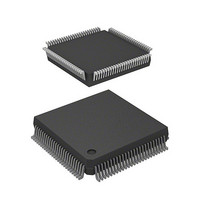D13007VX13V Renesas Electronics America, D13007VX13V Datasheet - Page 213

D13007VX13V
Manufacturer Part Number
D13007VX13V
Description
MCU 3V 0K 100-TQFP
Manufacturer
Renesas Electronics America
Series
H8® H8/300Hr
Specifications of D13007VX13V
Core Processor
H8/300H
Core Size
16-Bit
Speed
13MHz
Connectivity
SCI, SmartCard
Peripherals
DMA, PWM, WDT
Number Of I /o
35
Program Memory Type
ROMless
Ram Size
4K x 8
Voltage - Supply (vcc/vdd)
2.7 V ~ 5.5 V
Data Converters
A/D 8x10b; D/A 2x8b
Oscillator Type
Internal
Operating Temperature
-20°C ~ 75°C
Package / Case
100-TQFP, 100-VQFP
Lead Free Status / RoHS Status
Lead free / RoHS Compliant
Eeprom Size
-
Program Memory Size
-
- Current page: 213 of 798
- Download datasheet (5Mb)
6. Bus Controller
DMAC: When the DMAC receives an activation request, it requests the bus right from the bus
arbiter. If the DMAC is bus master and the DRAM interface or an external bus master requests the
bus, the bus arbiter transfers the bus right from the DMAC to the bus master that requested the
bus. The bus right is transferred at the following times.
The bus right is transferred when the DMAC finishes transferring one byte or one word. A DMAC
transfer cycle consists of a read cycle and a write cycle. The bus right is not transferred between
the read cycle and the write cycle.
There is a priority order among the DMAC channels. For details see section 7.4.9, Multiple-
Channel Operation.
DRAM Interface: The DRAM interface requests the bus right from the bus arbiter when a refresh
cycle request is issued, and releases the bus at the end of the refresh cycle. For details see section
6.5, DRAM Interface.
External Bus Master: When the BRLE bit is set to 1 in BRCR, the bus can be released to an
external bus master. The external bus master has highest priority, and requests the bus right from
the bus arbiter y driving the BREQ signal low. Once the external bus master acquires the bus, it
keeps the bus until the BREQ signal goes high. While the bus is released to an external bus
master, the H8/3006 and H8/3007 chip holds the address bus, data bus, bus control signals (AS,
RD, HWR, and LWR), and chip select signals (CSn: n = 7 to 0) in the high-impedance state, and
holds the BACK pin in the low output state.
The bus arbiter samples the BREQ pin at the rise of the system clock (φ). If BREQ is low, the bus
is released to the external bus master at the appropriate opportunity. The BREQ signal should be
held low until the BACK signal goes low.
When the BREQ pin is high in two consecutive samples, the BACK pin is driven high to end the
bus-release cycle.
Figure 6.46 shows the timing when the bus right is requested by an external bus master during a
read cycle in a two-state access area. There is a minimum interval of three states from when the
BREQ signal goes low until the bus is released.
Rev.5.00 Sep. 12, 2007 Page 183 of 764
REJ09B0396-0500
Related parts for D13007VX13V
Image
Part Number
Description
Manufacturer
Datasheet
Request
R

Part Number:
Description:
Rectifier diode. All purpose high power rectifier diodes, Non-controllable and half controlled rectifiers. Vrrm = 200V, Vrsm = 300V.
Manufacturer:
Usha Ltd.

Part Number:
Description:
Rectifier Diode, 800V, 130A, Silicon Diode, All purpose high power rectifier diode
Manufacturer:
Usha Ltd.

Part Number:
Description:
KIT STARTER FOR M16C/29
Manufacturer:
Renesas Electronics America
Datasheet:

Part Number:
Description:
KIT STARTER FOR R8C/2D
Manufacturer:
Renesas Electronics America
Datasheet:

Part Number:
Description:
R0K33062P STARTER KIT
Manufacturer:
Renesas Electronics America
Datasheet:

Part Number:
Description:
KIT STARTER FOR R8C/23 E8A
Manufacturer:
Renesas Electronics America
Datasheet:

Part Number:
Description:
KIT STARTER FOR R8C/25
Manufacturer:
Renesas Electronics America
Datasheet:

Part Number:
Description:
KIT STARTER H8S2456 SHARPE DSPLY
Manufacturer:
Renesas Electronics America
Datasheet:

Part Number:
Description:
KIT STARTER FOR R8C38C
Manufacturer:
Renesas Electronics America
Datasheet:

Part Number:
Description:
KIT STARTER FOR R8C35C
Manufacturer:
Renesas Electronics America
Datasheet:

Part Number:
Description:
KIT STARTER FOR R8CL3AC+LCD APPS
Manufacturer:
Renesas Electronics America
Datasheet:

Part Number:
Description:
KIT STARTER FOR RX610
Manufacturer:
Renesas Electronics America
Datasheet:

Part Number:
Description:
KIT STARTER FOR R32C/118
Manufacturer:
Renesas Electronics America
Datasheet:

Part Number:
Description:
KIT DEV RSK-R8C/26-29
Manufacturer:
Renesas Electronics America
Datasheet:

Part Number:
Description:
KIT STARTER FOR SH7124
Manufacturer:
Renesas Electronics America
Datasheet:










